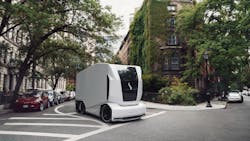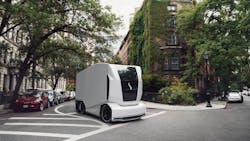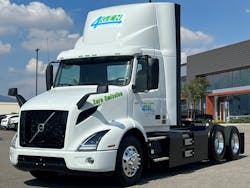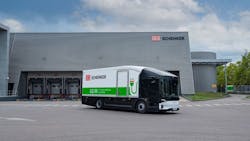Autonomous, electric, and the 'truck of the future'
AUSTIN, Texas—The “truck of the future” looks very different depending on who you talk to and which segment of the commercial vehicle market they serve.
That truck could be a fully autonomous pod that has no driver compartment and runs solely on battery-electric power. Or maybe it’s a freight-hauling tractor-trailer combination that has a centered driver seat, e-mirrors, and provides drivers with a 220-degree field of vision in urban settings. Perhaps it’s a traditional tractor or straight truck equipped with advanced driver assistance systems, different levels of automation, and a zero-emission power solution.
Regardless of what the vehicle might look like, several speakers during a full day of truck technology panel sessions and presentations at the Move America 2022 conference in downtown Austin agreed that a combination of truck safety, emission-reduction technologies, electric vehicle cost parity, and optimal vehicle utilization will reign supreme.
During a discussion on the road freight industry, Niklas Reindahl, Einride’s general manager of North American operations, criticized today’s “highly fragmented” value chain of OEMs, carriers, shippers, and logistics providers for not fully leveraging newer technologies to help further drive efficiencies. That, he noted, has prompted a massive underutilization of equipment today.Einride got its start in Sweden developing fully autonomous electric transport systems. The company recently expanded into the U.S. and has partnered with Maersk to deliver 300 connected electric trucks for its U.S. terminal operations.
See also: Einride’s new smart trailer designed for its humanless Pods, other EV tractors
“I think because the business has been the same for the last 100 years is part of the problem,” Reindahl said, noting that the biggest utilization opportunities are determined by shipper-carrier relationships.
“Adopting new technology is difficult sometimes,” he added. “You need a turnkey solution to deploy that technology. The problem is deploying new technology in a value chain that hasn’t changed in 100 years is a challenge.”
When asked about ongoing labor challenges, Reindahl said: “Labor is one way of looking at it; an underutilized transport system is another way of looking at it. We are looking at 50% utilization of the system because transport solutions are not being deployed in an intelligent way today. If we solve efficiency and utilization, we’re actually solving the driver shortage.”
As more and more end customers and consumers today want freight moved in a cost-efficient, yet environmentally sustainable way, fleets are trying to wrap their heads around the cost of battery-electric trucks today compared to their diesel counterparts—about $300,000 compared to approximately $150,000, respectively. That doesn’t include charging infrastructure and federal excise taxes.
“The battery is half the cost of the truck,” John Moore, product manager for electric vehicles at Volvo Trucks North America, said during a separate panel discussion with Rick Mihelic, director of emerging technologies at the North American Council for Freight Efficiency (NACFE). “Until we can get the battery prices down and move into cell chemistries that allow us to do that, we are going to have to have heavy incentives to cover [battery-electric trucks].”
Einride’s Reindahl did, however, point out that because electricity is lower than the cost of diesel, the business case for an electrified—and highly utilized—transport system makes sense today.Although Volvo has its sights set on battery-electric as an end goal to meet its own sustainability goals, the OEM is using a three-pronged approach to sustainable mobility—battery-electric vehicles, fuel-cell electric vehicles, and, in some areas, hydrogen internal combustion engines.
When asked what Volvo’s plan is to move forward on increasing the volume of battery-electric trucks in the market, Moore said: “Our business at Volvo is primarily long haul. That’s our biggest segment, and that is the hardest segment to electrify right now.”
Redesigned for safety
For Julie Johnson, head of market development and growth for Volta Trucks, the urban delivery space is “the playground for electric trucks.”
Urban environments present emissions and air-quality issues for everyone, including the drivers that pick up and deliver freight in these highly congested areas. In addition to addressing environmental health problems, pedestrian safety measures are necessary for regional and urban delivery fleets.Considering these factors, Volta Trucks developed the Volta Zero fully electric commercial vehicle created specifically for urban freight distribution. At first glance, the futuristic 35,274-lb. delivery truck looks like a city bus. The goal for Volta designers and engineers, Johnson noted during a Move America presentation, was to create a safer truck that could navigate bustling urban settings every day.
The cab and driver working area is designed to give drivers a better field of view—with large windows and a low, central seating position with a 220-degree view on city streets.
“Safety is a big focus regardless of what your fuel is,” Johnson said. “It’s important that we can reduce roadway fatalities. We can add technology and minimize blind spots in these redesigned trucks, and I think we will see a lot of that coming in the future.”
See also: Volvo to begin customer testing of fuel-cell trucks in 2025
The Volta Zero also features a minimal cab design with simplistic digital screens that are designed to keep distractions down for the driver. In addition, e-mirrors rather than traditional side mirrors help eliminate blind spots for the driver.
“We are coming to the U.S., and the goal is not to put side mirrors on the vehicle,” Johnson said. “There are no issues with having a biker on your right or left side and having to look out the window.”The truck also has sliding side doors with windows—similar to what you might see on a bus—so the driver can see pedestrians, bikers, and folks on scooters more clearly. The other critical piece to these sliding doors is the driver’s ability to easily step in and outside of the vehicle on both the left and right side of the vehicle.
“We know that cities are being redesigned and as we go through these exercises and redesigns, we will have more one-way streets,” Johnson explained, noting the importance of having the flexibility to park on the right or the left curbside. “Getting into a Class 6 or 7 truck is a lot for a driver. In an urban setting these drivers are moving and distributing goods, and they are getting in and out of that vehicle 20 times. There is a risk that they can fall out of the vehicle, plus there is a lot of physical wear and tear that happens on the drivers as well.”
At the end of the day, designing technology that is more supportive for drivers is the way of the future, Johnson added.
About the Author

Cristina Commendatore
Cristina Commendatore is a past FleetOwner editor-in-chief. She wrote for the publication from 2015 to 2023.




